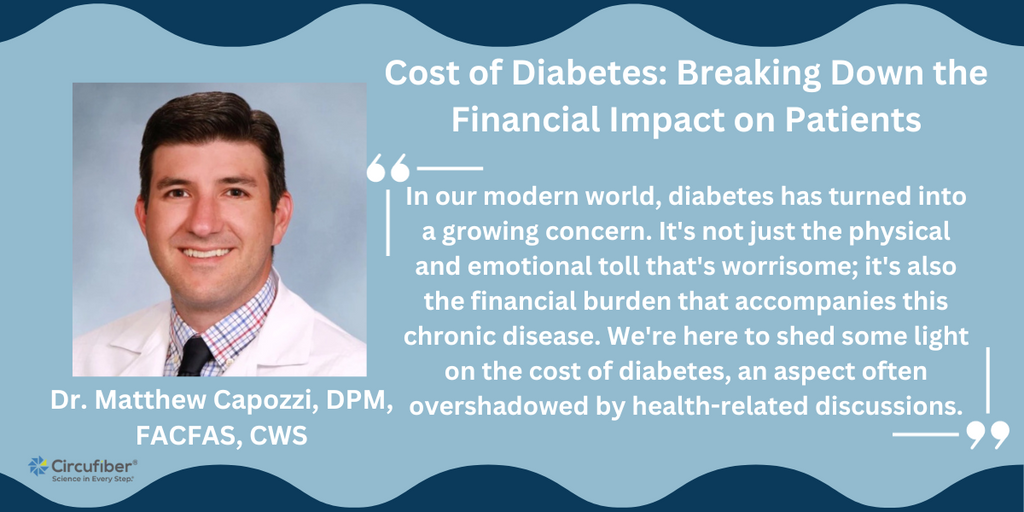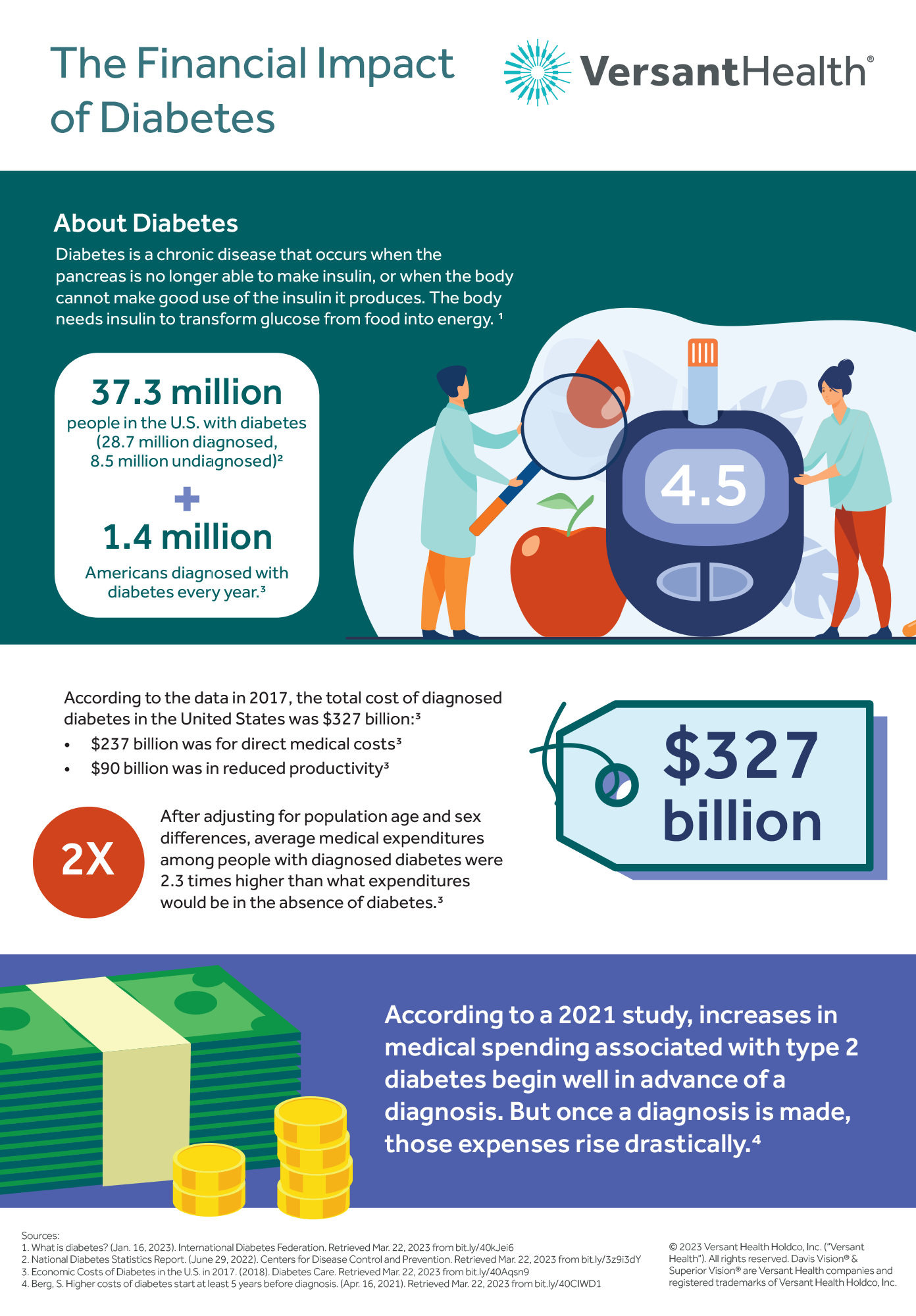Medically Reviewed by:Scientific Advisory Board
In our modern world, diabetes has turned into a growing concern. It's not just the physical and emotional toll that's worrisome; it's also the financial burden that accompanies this chronic disease. We're here to shed some light on the cost of diabetes, an aspect often overshadowed by health-related discussions.

Managing diabetes isn't cheap and we'll show you why. From frequent doctor visits to daily medications, lifestyle adaptations, and indirect costs like loss of productivity - everything adds up quickly. And what about those without insurance? It's a grim picture indeed.
On top of individual costs, let's not forget how diabetes affects our economy as a whole. The soaring healthcare expenses related to diabetes treatment put a significant strain on public resources. In short, the cost of diabetes is much more than just personal—it reaches into every corner of society.
Understanding the Financial Impact of Diabetes
We're digging into the financial impact of diabetes, a topic that isn't discussed as often but is just as important. It's not just about managing blood sugar levels and regular doctor visits - there are significant costs associated with this chronic condition.
Firstly, let's look at direct medical expenses. These include everything from testing supplies to insulin, medications for controlling blood pressure and cholesterol levels, hospital stays, and regular check-ups. According to the American Diabetes Association (ADA), people with diagnosed diabetes incur average medical expenditures of $16,752 per year, which is 2.3 times higher than what would be incurred by individuals without diabetes.
| Medical Expenditure | Average Cost Per Year |
|---|---|
| Testing Supplies | $1,685 |
| Insulin & Medications | $5,705 |
| Doctor Visits & Hospital Stays | $9,362 |
Next up are indirect costs like reduced productivity at work due to illness or disability linked to diabetes complications. For example:
- Missing a day at work because you have to visit the doctor
- Feeling too unwell to perform tasks efficiently These might not seem like big deals initially but they add up over time.
Then there are intangible costs – elements that aren't easily quantified but significantly affect quality of life. This could include the stress and anxiety associated with managing a chronic disease daily or even the loss of opportunities because one has to prioritize health above all else.
The financial burden doesn't stop there though. There's also an economic ripple effect where families may need to adjust their budget and lifestyle in order to accommodate for these additional expenses related to diabetes care.
It's clear that the cost of diabetes extends far beyond medical bills. It's a considerable burden that affects not just individual patients but also their families and society as a whole.
Direct Costs Associated with Diabetes Care
Navigating the financial landscape of diabetes care can feel like a daunting endeavor. We're here to break down the direct costs associated with managing this chronic condition and what they mean for those living with diabetes.
One major expense is medication. Insulin, the life-saving drug that many diabetics depend on, has seen a sharp increase in price over recent years. According to a study by the American Diabetes Association (ADA), annual insulin costs for patients rose from $2,864 in 2012 to $6,000 in 2022.
| Year | Annual Insulin Cost |
|---|---|
| 2012 | $2864 |
| 2022 | $6000 |
Then there's the cost of supplies needed to manage diabetes daily such as glucose meters, test strips and lancets. The ADA found that Americans with diabetes spend an average of $500 annually on these supplies alone.
Unfortunately, hospitalizations due to complications are not uncommon among people with diabetes. It's estimated that a single hospital stay could cost upwards of $1,500 even after insurance coverage is taken into account.
While these numbers might seem overwhelming it's important not to lose sight of your health amidst all this talk about costs. There are assistance programs available and strategies one can adopt to help mitigate some of these expenses while ensuring their well-being remains a top priority.

Indirect Costs: The Hidden Burden of Diabetes
Peeling back the curtain on diabetes, we'll find that there's a whole lot more to consider beyond the immediate medical costs. We're talking about indirect costs here; those sneaky expenses that often go overlooked, but can significantly impact a person living with diabetes.
First off, let's take a look at lost productivity. Say you're unable to work due to frequent doctor's appointments or you're not feeling well enough because of your condition. That results in lost wages and if it happens regularly, it starts adding up real quick. A study published by American Diabetes Association estimated that
| Lost Work Days | Reduced Productivity |
|---|---|
| 120 million | $20 billion |
in 2017 alone for people diagnosed with diabetes.
Now imagine needing special equipment or modifications around your home due to complications from diabetes. These are additional out-of-pocket expenses that aren't necessarily covered by insurance but are essential for maintaining quality of life.
Another aspect is transportation costs associated with regular check-ups and treatment sessions. For folks living in rural areas where healthcare facilities may be miles away, this becomes an even bigger concern.
What about emotional toll? It's hard to quantify the psychological impact, but suffice it to say, dealing with chronic illness like diabetes can lead to increased stress levels which could potentially spiral into mental health issues such as depression or anxiety over time.
- Lost productivity
- Out-of-pocket expenses
- Transportation costs
- Emotional distress
These are just some examples of hidden costs associated with diabetes management - all contributing towards making life just a bit harder for those living with this disease. By being aware of these indirect costs and planning accordingly, we can better manage our finances and overall health while navigating through our journey with diabetes.
Comparing the Cost of Diabetes Globally
When we look around the world, it's clear that diabetes isn't just a health crisis—it's a financial one too. Costs associated with diabetes vary greatly from country to country, largely due to differences in healthcare systems and economies.
In developed nations like the United States, direct costs such as medical care for diabetes-related complications can be extraordinarily high. According to data from the American Diabetes Association, Americans diagnosed with diabetes incur average medical expenditures of about $16,752 per year—roughly 2.3 times higher than what expenditures would be without diabetes.
In contrast, low-income countries often grapple more with indirect costs related to lost productivity and premature death. For instance, in sub-Saharan Africa where access to insulin is limited and costly—a single vial of insulin can cost up to half a month's wages—the economic impact of untreated or poorly managed diabetes can be devastating. Individuals unable to work due to illness not only suffer personal economic loss but also contribute less economically on a societal level.
Here are some statistics highlighting the differential costs:
| Country | Direct Costs (USD) | Indirect Costs (USD) |
|---|---|---|
| USA | ~$16,752 per person/year | Considerable but challenging to quantify |
| Sub-Saharan Africa | Varies greatly; Insulin costs up to half a month’s wages | Significant due primarily to lost productivity |
Meanwhile in Europe, where many countries have universal healthcare systems, patients typically don't bear the brunt of direct medical costs as they do in America. However, governments face substantial expenditure on treating and managing diabetes within their populations. In 2019 alone, European healthcare systems spent an estimated $166 billion on diabetes care.
What these global comparisons underscore is that while the face value cost may differ significantly between regions based on various factors—the human cost remains universally high.
Conclusion: Managing the Economic Challenge of Diabetes
Managing the economic challenge of diabetes isn't easy but it's necessary. We've got to understand that this chronic disease doesn't just impact individuals physically, but financially too.
There are several steps we can take to manage these costs:
- Early detection and proper management: Regular medical check-ups and blood glucose tests can lead to early detection. Proper management involves adhering to medication, planning a healthy diet, and regular exercise.
- Health insurance plans: Choose a plan that covers most diabetes-related expenses such as medications, test strips, doctor visits or hospital stays.
- Lifestyle changes: Adopting healthier habits like exercising regularly, eating balanced meals, quitting smoking or limiting alcohol can potentially reduce health complications related to diabetes.
Remember though it's not about cutting corners where health is concerned. The idea is simply about making informed decisions for better financial management without compromising your health.
References, Studies and Sources:
https://diabetes.org/about-us/statistics/cost-diabetes
More About Circufiber.com and Healthcare disclaimer:
Always consult your physician before beginning any program. This general information is not intended to diagnose any medical condition or to replace your healthcare professional. If you experience any pain or difficulty, stop and consult your healthcare provider. Circufiber.com socks are clinically proven to improve micro-circulation in feet and lower extremities in people with Diabetes.
More Author Information:
Dr. Capozzi is a board-certified foot surgeon through the American Board of Foot and Ankle Surgery. He is a Diplomate of the American Academy of Wound Management and Fellow of the American College of Foot and Ankle Surgeons. He completed a three-year residency program in Foot and Ankle Reconstructive Surgery at St. Francis Hospital & Medical Center in Hartford, CT in 2010. Dr. Capozzi is a board-certified Wound Specialist® granted by the American Academy of Wound Management. He is also board-certified in Foot Surgery through the American Board of Foot and Ankle Surgery.




